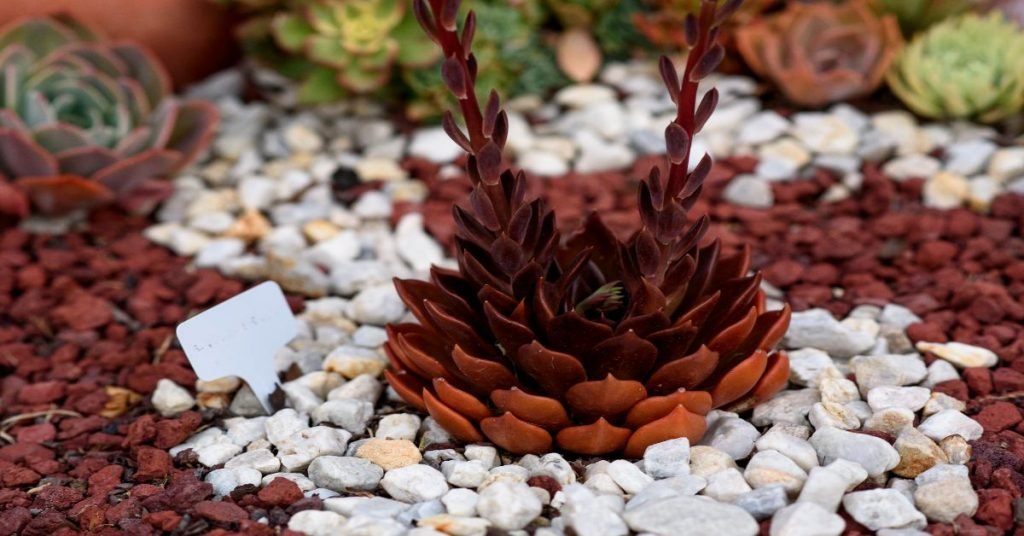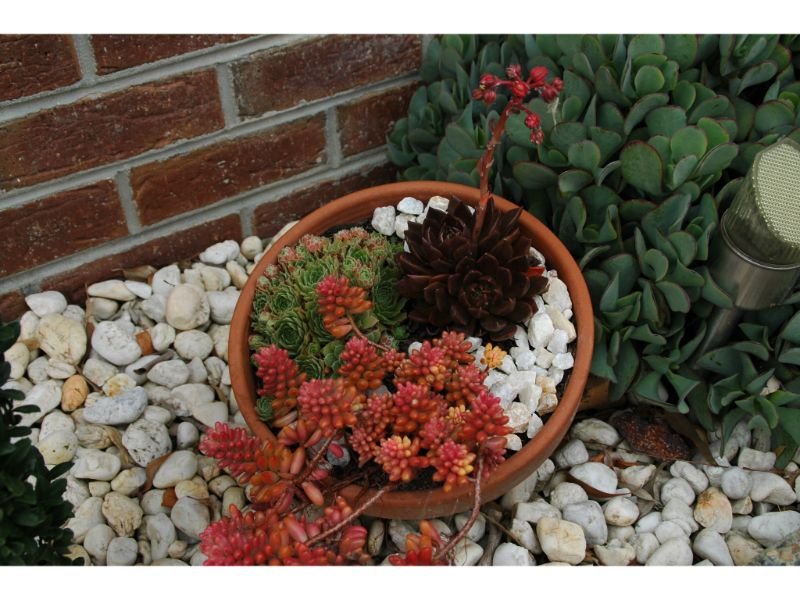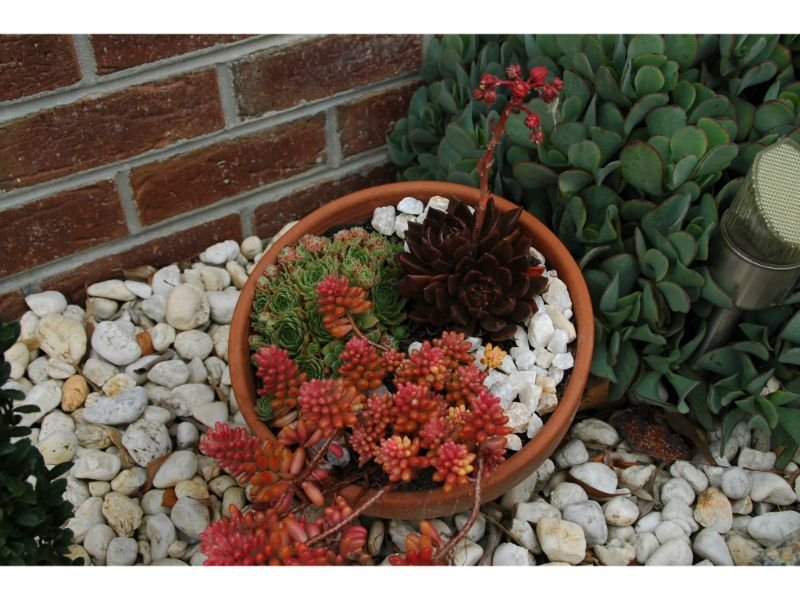Black rose echeveria is a popular choice for succulent enthusiasts, and there’s no denying why. With its unique dark appearance and easy care requirements, it has become a staple in many indoor gardens. But what exactly is black rose echeveria?

Table of Contents
The Brief Overview of Black Rose Echeveria
Black rose echeveria, also known as Echeveria ‘Black Prince’, is a small succulent plant that belongs to the Crassulaceae family.
This succulent is often referred to as Echeveria cv. Black Princes Rose where the ‘CV’ stands for ‘Cultivar’ or ‘Cultivation Variety’ mean they are not naturally occurring species in nature but rather a cultivation product by human.
It is native to Mexico and has become increasingly popular due to its distinctive deep purple, almost black coloration of its rosette-shaped leaves. The plump leaves are arranged in an attractive rosette pattern around the central stem, giving the plant a symmetrical look that is hard to resist.
Why It’s a Popular Choice for Succulent Enthusiasts
Succulents have been all the rage in recent years, and black rose echeveria definitely stands out among them. Its intense coloration appeals to many indoor gardeners and can add a pop of interest to any collection or arrangement.
Additionally, black rose echeveria requires minimal watering and maintenance which makes it an easy choice for those who are just starting their indoor garden journey or those who do not have much time to spend on plant care. But beyond its aesthetic appeal and low-maintenance needs lies another reason why black rose echeveria could be seen as such a popular choice among succulent enthusiasts: social media validation.
Yes, I said it – social media validation! With Instagram accounts dedicated solely to indoor plants with massive followings (and even hashtags like #plantsofinstagram), having an aesthetically pleasing collection of plants can bring about feelings of social validation or gratification from others online.
While the popularity of black rose echeveria may stem from its appearance and easy care requirements, it is also undeniable that social media plays a role in the hype around this plant and other indoor plants. Nevertheless, as a succulent enthusiast myself, I can attest that black rose echeveria is a great addition to any collection and deserves the attention it has garnered.
What is Black Rose Echeveria?

Black Rose Echeveria, also known as Echeveria ‘Black Prince,’ is a succulent plant that is highly sought after for its striking appearance. As the name suggests, the leaves of this plant are a deep, dark blackish-purple color that adds a bold touch to any succulent collection.
The leaves form a rosette shape and are thick and fleshy, making them an ideal choice for beginners in succulent gardening. The plant typically grows to about 6 inches in height and 8 inches in width when mature.
It may produce small clusters of pink flowers on tall stems during the summer months. However, the primary attraction of this plant lies in its foliage rather than its blooms.
Description of the Plant’s Appearance and Characteristics
The leaves of Black Rose Echeveria are spoon-shaped and grow up to 4 inches long by 2 inches wide in mature plants. They have a waxy texture and are covered with powdery white or gray pruinose which gives them an ethereal look. The tips of the leaves have pointed edges that curve slightly upwards giving them an almost other-worldly appearance.
The rosette itself is compact with tightly packed leaves that grow from the center outwards forming concentric circles around it. The base of each leaf overlaps with those of neighboring ones creating a tight-knit cover over the soil surface.
History and Origin of the Plant
The origin of Black Rose Echeveria can be traced back to Mexico where it grows naturally in rocky areas with well-draining soil conditions. It belongs to the Crassulaceae family which includes other popular succulents such as jade plants (Crassula ovata) and hen-and-chickens (Sempervivum). Initially discovered by horticulturist and collector Dick Wright in Northern California in the 1970s, the Black Prince was later bred by hybridizer Hans Hansen.
It was introduced into the market in the late 1990s and has since become a popular choice for both novice and experienced succulent gardeners. Black Rose Echeveria is a plant of remarkable beauty that is sure to captivate any succulent enthusiast.
Its striking appearance combined with its hardiness and ease of care make it an ideal choice for indoor or outdoor gardening. With proper attention to lighting, watering, soil conditions, and propagation techniques, you can keep this plant thriving for years to come!
How to Care for Black Rose Echeveria

Lighting: Shedding Some Light on Black Rose Echeveria’s Needs
As a succulent enthusiast, you know that lighting is one of the most important factors influencing plant growth and coloration. Black rose echeveria is no exception. This stunning plant needs plenty of bright, direct sunlight to thrive, but be careful not to expose it to too much heat.
Aim for at least six hours of full sun per day, but if you live in a particularly hot or sunny area, you may need to provide some shade during the hottest part of the day. Don’t have access to natural sunlight?
No problem! You can grow black rose echeveria under artificial lights as long as you choose the right type of bulb.
Look for LED grow lights with a color temperature between 5500K and 6500K for optimal growth and coloration.
Watering: Water You Waiting For? Hydration Tips for Your Black Rose EcheveriaWhen it comes to watering black rose echeveria, less is more. These plants are adapted to survive in drought conditions and can actually rot if overwatered. Aim to water your black rose echeveria once every two weeks or when the soil feels completely dry. When watering your plant, make sure you give it a thorough soak until water starts dripping out of the drainage holes at the bottom of its container. Then allow all excess water to drain away before placing your plant back in its usual spot.
Soil and Fertilizer: The Dirt on Soil – Finding the Perfect Mix for Your Black Rose Echeveria
Black rose echeveria needs well-draining soil that is rich in organic matter. When potting your plant, choose a soil mix that is specifically designed for succulents, or make your own by mixing together equal parts of sand, perlite, and peat moss.
Fertilization should be done sparingly, only once or twice a year during the plant’s growing season. Use a balanced fertilizer with an NPK ratio of 10-10-10 and dilute to half strength before applying.
Propagation: Growing Your Family Tree – How to Propagate Your Black Rose Echeveria
Propagation is an easy and rewarding way to expand your collection of black rose echeveria. The most common method of propagation is by taking stem cuttings from the parent plant.
To propagate your black rose echeveria, simply take a stem cutting that is at least three inches long and remove its lower leaves. Allow the cutting to dry out for a day or two before planting it in well-draining soil.
Water sparingly until new roots and growth appear. With these care tips in mind, you’ll be able to keep your black rose echeveria healthy and thriving for years to come!
Common Issues with Black Rose Echeveria
Pests: A Thorn in the Side of Your Succulent
As a succulent enthusiast, it’s frustrating to see your beloved black rose echeveria under attack by pests. Unfortunately, these little critters are common issues for this plant, but don’t worry, with proper care and attention you can eradicate them.
The most common pests that affect black rose echeveria are mealybugs, spider mites, and scale insects. Mealybugs are small white insects that look like cotton or fuzz on the leaves of your plant.
They feed on the sap of your succulent which can lead to yellowing and stunted growth. Spider mites are tiny red or brown insects that create webs on the plants’ foliage; they suck out the moisture from your plant causing yellowing leaves and brown spots.
Scale insects are brown or gray bumps usually found on stems or undersides of leaves that cause wilting and leaf drop. To prevent pest infestations in your black rose echeveria plant, regularly inspect your plants for signs of bugs.
If detected early enough you can remove them with a cotton swab dipped in rubbing alcohol or neem oil. In more severe cases, you may need to use insecticidal soap or systemic pesticides.
Conclusion
Caring for a black rose echeveria isn’t rocket science but it does require patience and attention to detail. Light is crucial for maintaining its beautiful coloration while adequate watering will prevent root rot and other problems.
Proper soil composition paired with regular fertilization will help keep your succulent thriving throughout the year. However, if things go wrong don’t be afraid to diagnose problems early before they get out of hand; pests may become an issue if left unchecked so be sure to keep an eye out for them.
With the right care, your black rose echeveria will reward you with its unique and stunning appearance. Happy growing!

Gardening is my passion and growing plants indoors has always been a stress relief for me. Grow a banana tree in my apartment once (although failed to produce bananas).






